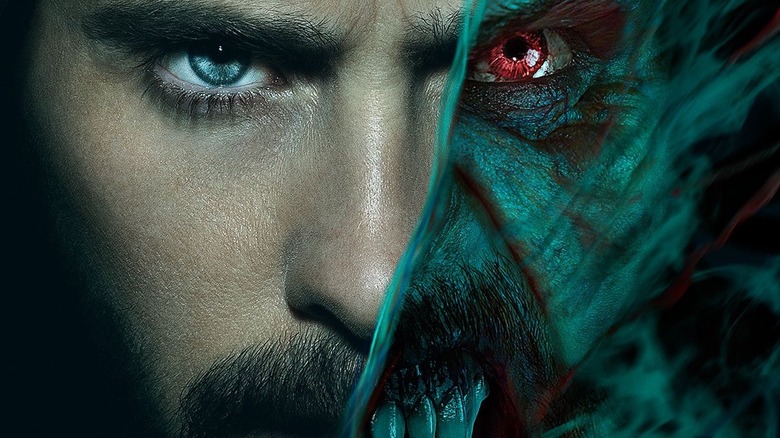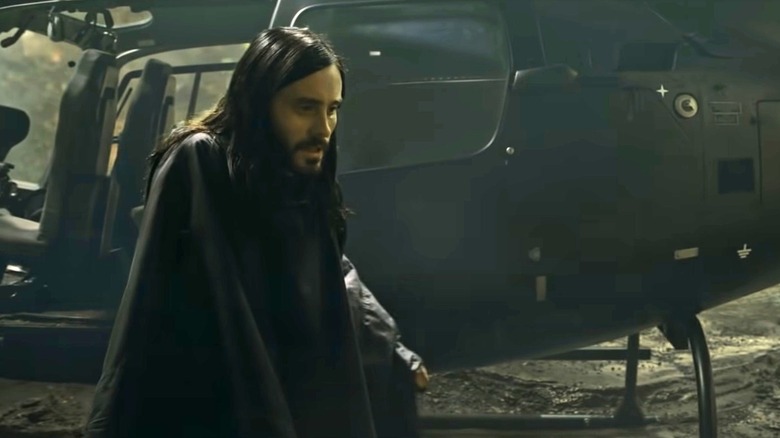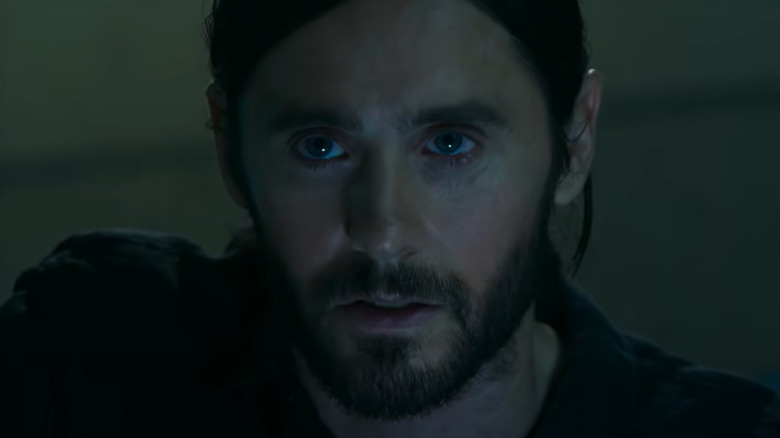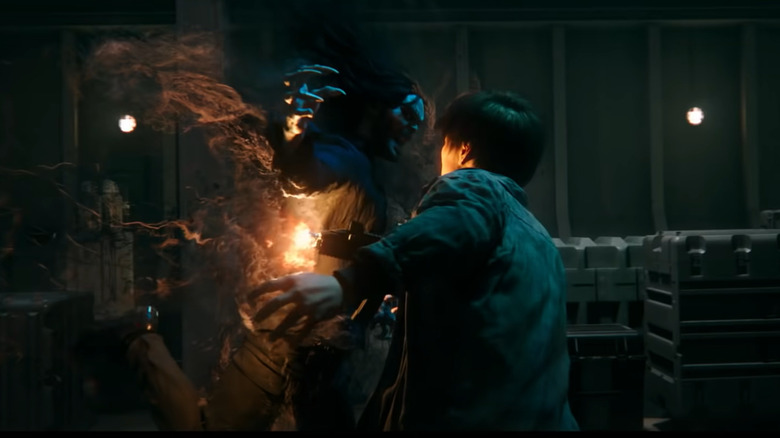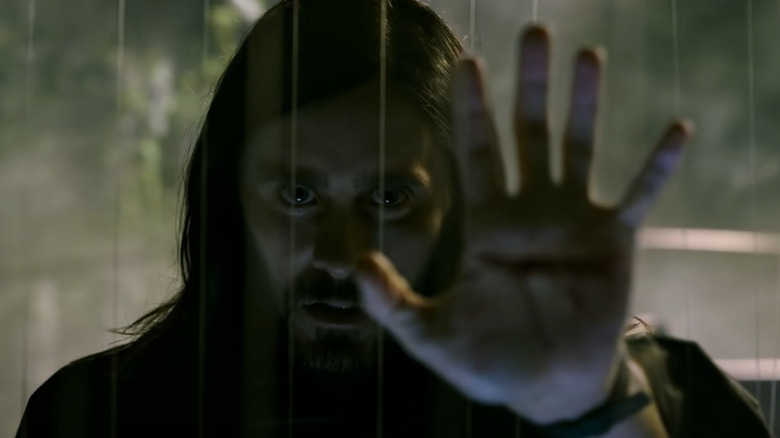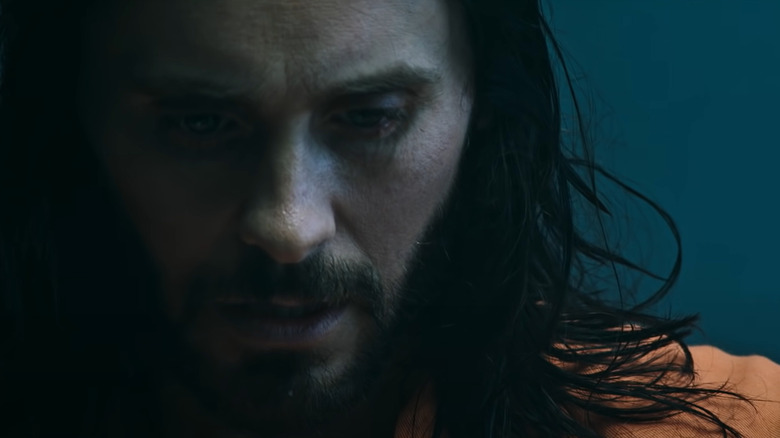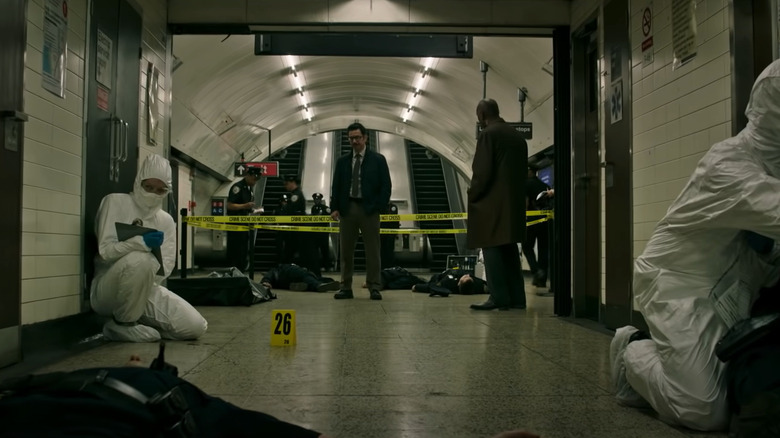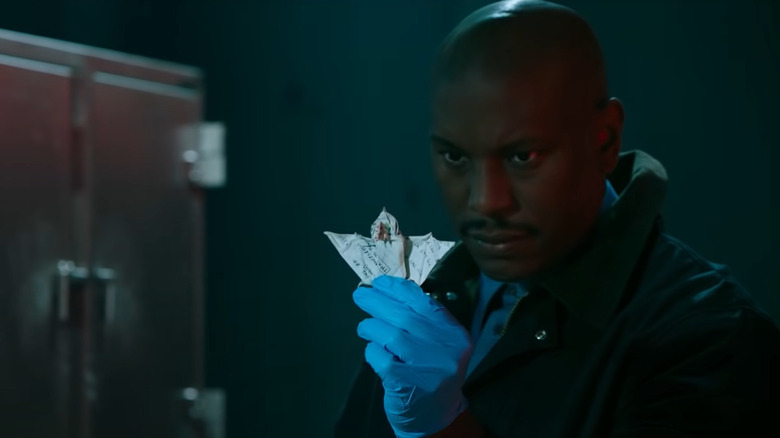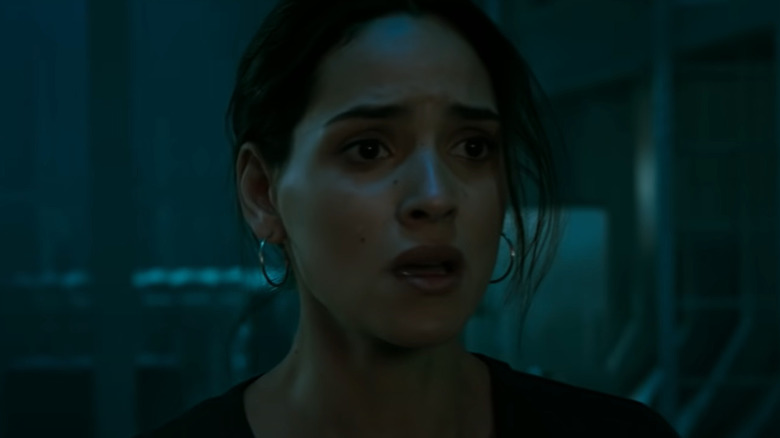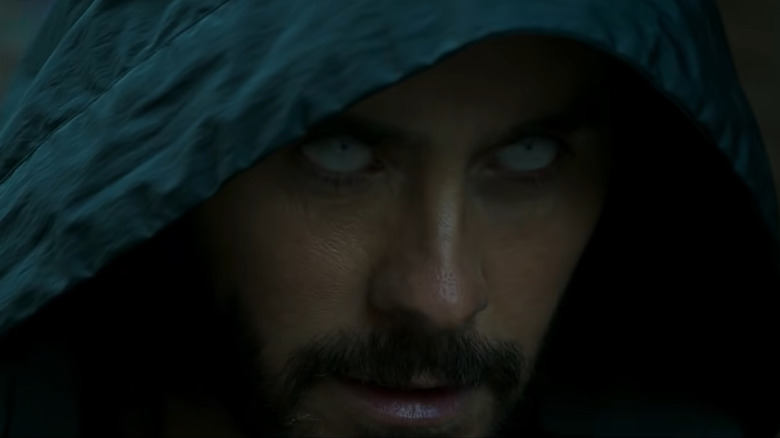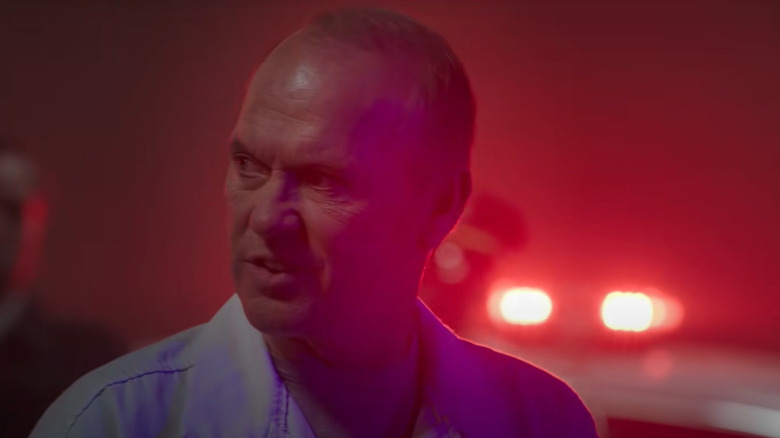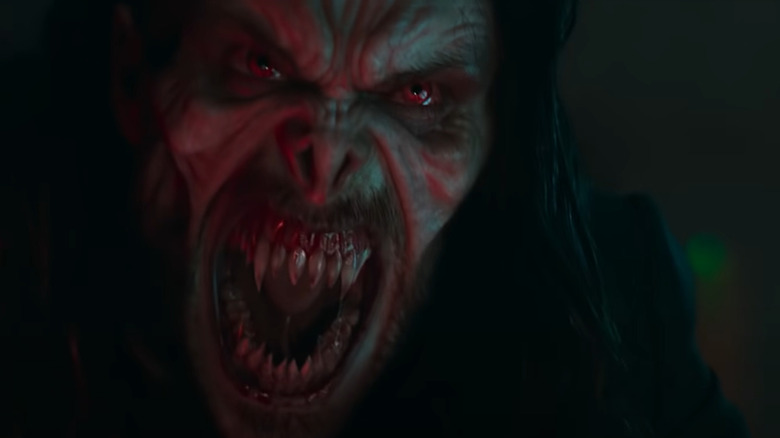The 6 Best And 6 Worst Things About Morbius
In the wake of "Venom" and "Venom: "Let There Be Carnage," Jared Leto's "Morbius" begins the second core series in Sony's Spider-Man Universe — an alternate comic book reality from the MCU consisting solely of the characters Sony still holds the film rights to. Because "Morbius" plays such a major role in expanding the SSU beyond the "Venom" movies, and because any competition to Marvel's cinematic superhero dominance is inherently interesting, a good deal of curiosity has surrounded the film prior to release.
Unfortunately, the finished product falls woefully short of the high standard Marvel Studios has set for the genre. "Morbius" is plagued by a range of problems, from pacing and structural issues to poor writing and a messy plot. That might not be too surprising given that the "Venom" films — despite doing quite well at the box office — have been critically panned, but it's still disappointing for fans of the "Morbius" comics.
Of course, even in a lackluster film like "Morbius," there can still be shining moments. Sony's superhero horror flick shows promise at times, and there are definitely bright spots amidst all of the film's issues. Here are the best things "Morbius" has going for it, as well as the absolute worst problems that drag the movie down. A word of warning: major spoilers ahead.
Best: Michael Morbius is an intriguing character
On paper, Jared Leto's Michael Morbius is a pretty compelling character. Suffering from a rare and usually fatal blood disease since birth, he becomes one of the world's leading experts on artificial blood and is even awarded a Nobel prize for his efforts. Morbius eventually attempts to cure his condition by splicing his own DNA with that of vampire bats, causing him to develop a number of supernatural abilities and a deep craving for human blood. Most of the film deals with Morbius' internal struggle as he tries to balance his new violent urges with the humanitarian ideals that he's always tried to live by.
That should be the formula for an emotionally intense and nuanced antihero story, and at times, "Morbius" shows glimpses of just that. Michael has contributed a lot of good to the world, and as the viewer, you truly believe that his experiments are largely motivated by a desire to help others. His best friend Milo (Matt Smith) in particular acts as a symbol of Morbius' selflessness. The two suffer from the same disease and met at a treatment center when they were only boys. It's clear that Morbius wants to help his friend, and he puts a lot of pressure on himself to do so.
At the same time, Morbius can be a pretty selfish man. Though his desire to help the world at large is genuine, his number one motivation seems to be his own quest for survival. There's a lot of rich potential in this tension between selflessness and self-preservation, and Morbius' vampire transformation could have been used to explore the character's inherent duality.
Worst: Morbius wastes its own main character
Michael Morbius starts out with a lot of potential for a nuanced, complex character arc. Unfortunately, the film wastes no time in squandering that potential. Unnecessary time jumps and a pitifully written childhood backstory sequence establish the character's tragic past in about as clinical a way as possible. As a result, the audience has no real emotional connection to Morbius by the time he undergoes his transformation. There's a face-value sympathy in a man who has spent his whole life on the brink of death, but the script seems to expect that premise to be enough, and very little time is spent developing Michael as an actual character.
Is he actually scared to die? Or is he doing it all for Milo? What is he living for? What does he want to leave behind? These are the kinds of questions that, if they'd been addressed on screen, could have made for a deeply textured character — perhaps one more deserving of Jared Leto's bizarre method acting techniques. Instead, viewers are graced with a stoic protagonist with excruciatingly little substance.
If "Morbius" treated its titular character as both the hero and villain of the story — a role for which he seems more than prepared — the result could have been unique and intriguing. Michael's innate survival instinct could have been pitted against his vows as a doctor to create a powerful internal conflict. Instead, Morbius forces an awkward villain storyline out of Matt Smith's Milo character, abandoning the potential of the source material in favor of the same tired superhero formula we've been watching for decades.
Best: Morbius the character looks cool
One of the best things "Morbius" has going for it is that the whole aesthetic surrounding the central character looks pretty cool. He has long vampire hair. He wears a black vampire trench coat. And when he fights, he flies around with a lightning-quick fighting style that's accentuated by some very stylish smoky swirly effects. Some might argue that Morbius' powers rely too heavily on CGI, but for the most part, that CGI does its job well.
"Morbius" is never better than when the Living Vampire is in action. The film's first major action sequence, which sees him take down a group of mercenaries on the ship where he mutates himself, is a definite highlight, blending the from-the-shadows tension of the "Batman" movies with the hard-hitting speed of Zack Snyder's Superman. The film never explains whether the smoke trails that accentuate Morbius' movements are a side-effect of his transformation, a result of his incredible speed, or a non-diegetic addition for the sake of the audience, but whatever it is, it looks pretty cool.
These stylistic touches expand in fun ways as Morbius acquires other powers later in the film — namely, his sonar pulse and an ability to fly. The special effects culminate in a genuinely striking scene where Morbius uses his echolocation to find a single heartbeat in New York City, then flies to it in a whirlwind of purple and black. It's honestly shocking that Leto looks so convincing as Morbius, considering that he's nearly twice the character's age.
Worst: Morbius the movie looks terrible
While the stylish aesthetic created around the Morbius character is quite effective, the rest of the movie suffers from a myriad of visual problems. Cinematographer Oliver Wood is a seasoned veteran of his craft, and it would be irresponsible to hold him solely responsible for the camera work in "Morbius," but a certain amount of blame does inevitably fall at his feet. Wood is perhaps most famous for his work on contemporary action movies like "Die Hard 2," "Face/Off," and the original "Bourne" trilogy. Though the "Bourne" films received critical acclaim, they've also become notorious in the years since for popularizing the use of shaky cam.
Not every issue with the cinematography in "Morbius" is due to shaky cam, but the technique is indicative of the larger problems plaguing the film's cinematic style. Nearly every scene is shot with the same level of intensity, jumping between pulled-back shots of whole rooms and hand-held close-ups of characters faces with reckless abandon. At best, it's mildly nauseating. At worst, it's practically unwatchable. Movies like "The Bourne Identity" can get away with this sort of frenetic aesthetic because of the intensity inherent to their plots. But in a superhero movie like "Morbius," it's hard to ground the necessary moments of exposition and character development when the camera won't sit still.
All these issues collide in the film's final battle, which quickly devolves from an exciting vampire duel into an avalanche of computer-generated mush.
Best: It's short
Modern superhero movies seem obsessed with competing for the longest runtime. Films like "Avengers: Endgame," "Spider-Man: No Way Home," and "The Batman" all clock in around the two-and-a-half to three hour range, which can be a big ask for moviegoers. Of course, all those films were also very well received upon release, so it could be argued that they needed their extra length to pull everything together.
Still, it's refreshing to see a superhero movie that keeps things short and sweet. "Morbius" is listed at an hour and 44 minutes, and it definitely never dwells too long on any one scene. It's a fast and furious movie, and not just because of the inclusion of Tyrese Gibson. In fact, if you compare the final film to the trailers, you'll see that lots of scenes and lines were removed for the final cut. If sitting through the three hours that a lot of other movies demand these days is a hard no-go for you, then you may be glad to see how brief "Morbius" truly is. And once you start watching it, you'll be even happier to know that it'll all be over soon.
Worst: Awful pacing
Despite its relatively short runtime, "Morbius" still has major pacing problems. It somehow manages to feel both sluggish and rushed at the same time, like riding in a stick-shift car being driven by someone without a license. The film opens with a beautiful vista shot of Costa Rica, where Michael Morbius has traveled to capture vampire bats. After a brief shot of him flippantly using his own blood as bait, the film jumps back in time 25 years for a stilted backstory sequence explaining his difficult childhood. After that, it's another abrupt cut to present-day New York, where Morbius is revealed to have successfully captured a whole swarm of bats off screen.
This sort of rapid-fire pacing continues throughout the film, but it gets even more distracting once the vampire transformation takes place. Morbius shows very little emotion in response to his monstrous state, with only a handful of loud outbursts to augment his otherwise stoic demeanor. If the movie ever slowed down for a second, it might be able to humanize Morbius and his struggle a bit more, but instead, the script keeps jumping between underdeveloped side characters and overwritten exposition. There's no time for viewers to catch their breath, much less develop any tangible emotional attachments.
Perhaps worst of all, this breakneck pace makes every section of the movie feel the same. The frantic camera work and abrupt scene transitions make it impossible to determine which moments are pivotal and which are supplemental, turning the entirety of "Morbius" into one long, repetitive act.
Best: The feds
Like the vampire for which it's named, "Morbius" is not entirely devoid of life. Most of the humor and humanity that can be found in the film comes from Tyrese Gibson and Al Madrigal, who play a pair of FBI agents investigating Morbius' activities. The interplay between Gibson's stone-cold persona and Madrigal's deadpan comedy is genuinely funny, with great moments like the latter bringing a "triple-blessed" vial of holy water to their interview with the vampire.
Madrigal and Gibson are so entertaining, in fact, that it's easy to envision a better version of "Morbius" where they play a larger role. Remove Milo's villain arc, focus more on Morbius' internal struggle, and slot the FBI agents into the antagonist role, and Sony could have had a campier (and ultimately more entertaining) movie on their hands.
Instead, the feds get relegated to a c-tier supporting cast position, and their occasional jokes are ultimately drowned out by the film's cacophonous self-seriousness. Gibson and Madrigal seem like a winning duo, though, and it would be great to see them return in bigger roles as Sony's Spider-Man Universe keeps expanding.
Worst: Bad supporting characters
For as good as the FBI agents are in "Morbius," the other supporting characters are deeply lacking. First and foremost, Matt Smith's Milo — based loosely on the character Hunger from the Marvel comics — is a terrible villain. From the moment he's introduced, it's painfully obvious that he'll eventually turn evil. And when he does turn evil, he receives no justification. He has a couple of throwaway lines about wanting normal people to feel the threat of death, just as he has for his whole life. With a better script, maybe Milo could have been an interesting exploration of how those with disabilities are cast aside in society, and how anger at the world can manifest in dangerous ways. Sadly, that's not what "Morbius" delivers. What we get instead is a completely flat sociopath. When Michael tells his friend "this isn't you," it's almost laughable; this is clearly the only thing Milo was ever written to be.
Equally disappointing is Michael's romantic subplot with Doctor Martine Bancroft, played by Adria Arjona. The actress does her best with a script that is constantly working against her, but her efforts just aren't enough. If you thought the days of movies forcing cardboard women into relationships with emotionally unavailable men were over, "Morbius" may offer at least one surprising twist for you. What actress wouldn't love to deliver meaty lines like, "I don't want you to get hurt," and, "You shouldn't be here," for the entirety of a movie?
Best: Style
The greatest trick that "Morbius" pulls is showing you glimpses of a better movie that could have been. The opening title card fades in over a cool synthwave graphic of hard lines and bright pinks, teasing a retro aesthetic that never comes to fruition. The hard-boiled humor of the FBI agents hints at pulpy noir, but that tone never gets enough of a foothold to influence the rest of the film. And of course, there are plenty of dark corridors to evoke the horror genre, which "Morbius" pulls from heavily.
In the moments where these stylistic touches are strongest, "Morbius" can be a pretty fun movie. Brought together in a more cohesive way, they could have yielded a solid film. Unfortunately, the movie refuses to fully commit to any of its more interesting aesthetics, languishing mostly in dreary exposition and ripping off scenes from better movies. The shot of Michael being swarmed by vampire bats in his lab is a particularly egregious instance of this, with a backing score that elicits memories of Hans Zimmer's "Batman Begins" score. Unfortunately, that's a comparison "Morbius" would probably be better off not even attempting to make.
Worst: Stuck in the past
Though it occasionally evokes other genres, "Morbius" is a superhero movie through and through. But even in that space, the film feels about two decades too late. Stuck next to the likes of the later MCU phases or Christopher Nolan's "Dark Knight" trilogy, "Morbius" looks woefully lacking. Rather than those more recent entries in the genre, "Morbius" is easier to compare to early-2000s movies like Ben Affleck's "Daredevil" or Halle Berry's "Catwoman."
From the clunky dialogue and overall angsty tone to the flat side characters, "Morbius" is a movie that feels stuck in the past — swooping in from an era when superhero films were bad more often than they were good, and before stars like Robert Downey Jr. proved that comic book exposition didn't have to sound dorky on camera. If "Morbius" leaned more into its retro vibe, if it allowed more of "The Crow" in and less of "Ghost Rider," perhaps Sony would have had something. Instead, we're left with a stark reminder of how far the superhero genre has come, and a series of questions about how a movie like "Morbius" got made in 2022.
Best: The Morbius post-credits scenes
Like most superhero movies of the modern era, "Morbius" peppers some teases for the future with its end credits. There are two post-credits scenes in the film, both of which focus on the return of Michael Keaton's Adrian Toomes character from "Spider-Man: Homecoming." Because Keaton is a fantastic actor, and because "Homecoming" is so beloved, it's undeniably fun to see Toomes brought back into the fold. It's even more fun to see a fresh take on his Vulture suit, even if the scene where it's revealed feels incredibly clunky.
Keaton's cameo is fun at first, but it also comes with its share of problems. For starters, seeing him at the end of "Morbius" mostly reminds viewers of a much better movie. Then there's the matter of how he actually appears in the "Morbius" universe, which is confusing to say the least. The first credits scene shows the sky over New York being fractured, clearly referencing the multiverse spell from "Spider-Man: No Way Home." However, that spell previously only brought characters from other realities into the MCU, not the other way around. So why does Toomes teleport to Michael Morbius' world? How does he get a new Vulture suit without any Chitauri technology? Is there even a Spider-Man in Sony's Spider-Man Universe? These are confusing questions to leave audiences with at the end of a movie, but given that the movie is "Morbius," they're a welcome distraction.
Worst: Morbius is a mess
From top to bottom, "Morbius" is a failure. It ruins all efforts at horror and tension by rushing through every scene. It kneecaps a potentially interesting protagonist by leaving him cold and underdeveloped. It is an hour and 44 minutes of messy plotting, clumsy dialogue, and nauseating cinematography, and it ends with one of the most egregious CGI slugfests in the history of superhero cinema.
The "Venom" movies are a long way from masterpieces, but they embrace their campy tone in a way that at least makes them entertaining to watch. "Morbius," on the other hand, is the worst kind of bad movie — the kind that's so messy and poorly constructed that it feels like a chore just to keep watching it. Sony clearly has high hopes for their interconnected "Spider-Man" universe, and with a live-action Sinister Six now feeling like a distinct possibility, those hopes may not be all in vain. But as the first proper expansion into that shared continuity, "Morbius" is a colossal disappointment. If Jared Leto were to compile every good moment of this film into one clip, it would barely be enough to make a Thirty Seconds to Mars music video.
